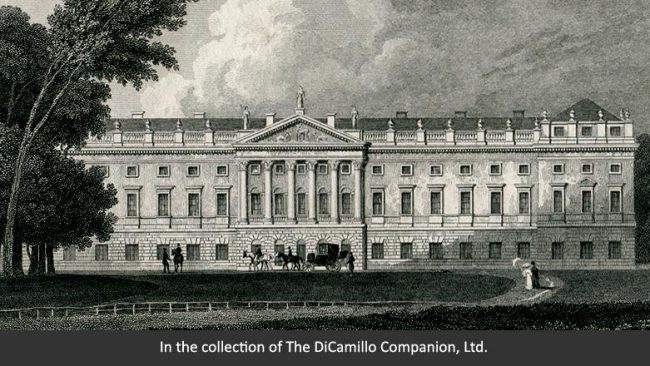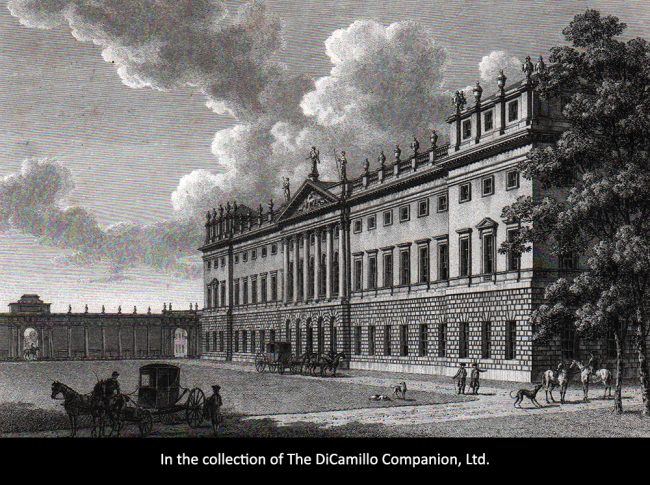
An 1830 engraving of the house from "Neale's Views of Seats"

The house from a 1780 engraving
Earlier Houses: Worksop Manor was the seat of the ancient lords of Worksop. A manor house of circa 1585 designed by Robert Smythson, burned in 1761 and replaced by Paine's house of 1763-67. The earlier manor served in 1568 as a prison of Mary, Queen of Scots.
House & Family History: One of the famed "Dukeries" (so called because this part of Nottinghamshire contained four ducal seats: Clumber House, Thoresby Hall, Welbeck Abbey, and Worksop Manor), the enormous house that James Paine designed for the 9th Duke of Norfolk to replace the earlier house was never completed. The house was to be a square of 305 feet, with a gargantuan Egyptian Hall (140 feet long) in the central courtyard, a tribune, and an enormous staircase. When construction was stopped in 1767, with only one wing fully completed, even that was palatial in scale. Had the house been completed, it would have been one of the largest houses ever built in England. In 1838 Henry, Earl of Surrey (eldest son and heir of the 12th Duke of Norfolk), sold the estate to the 4th Duke of Newcastle for £375,000 (worth approximately £260 million in 2012 values, using the labor value commodity index). The duke stripped the house of lead and fittings and demolished the main wing (he was only interested in the estate, which was contiguous to his own Clumber Park Estate). In the mid-19th century what was left (the service wing, parts of the eastern wing, and the stableblock) were coalesced into a new house, which still stands. This ashlar house is a quadrangle of 23 bays wide by 14 bays deep, with hipped slate roofs. Traditionally, the lord of the manor of Worksop may assist a British monarch at his or her coronation by providing a glove and putting it on the monarch's right hand and supporting his or her right arm. King James I stayed at Worksop in 1603 on his progress south from Scotland to take the throne of England.
Comments: Christopher Hussey believed that, had Worksop been completed to Paine's plans, it would have been his masterpiece.
Garden & Outbuildings: Smythson also designed Worksop Manor Lodge, which survived virtually unaltered until 2007, when it burned down (it is currently being restored). Robert Abraham's works, including the gardener's cottage, were built for the Earl of Surrey. The Triumphal Arch from James Paine's work at Worksop is extant. Since the early 20th century the estate has been home to Worksop Manor Stud, which breeds thoroughbred horses.
Architect: James Paine Sr.
Date: 18th centuryArchitect: James Paine Sr.
Date: 1763-67Architect: Robert Smythson
Date: Circa 1585Architect: Robert Abraham
Date: Circa 1830John Preston (J.P.) Neale, published under the title of Views of the Seats of Noblemen and Gentlemen in England, Wales, Scotland, and Ireland, among other titles: Vol. III, 1820.
Country Life: CLIII, 678, 750 plan, 1973.
Title: Biographical Dictionary of British Architects, 1600-1840, A - SOFTBACK
Author: Colvin, Howard
Year Published: 1995
Reference: pgs. 48, 726, 903
Publisher: New Haven: Yale University Press
ISBN: 0300072074
Book Type: Softback
Title: English Country Houses: Early Georgian, 1715-1760
Author: Hussey, Christopher
Year Published: 1955
Publisher: London: Country Life Limited
ISBN: NA
Book Type: Hardback
Title: Hardwick Hall Guidebook
Author: Girouard, Mark
Year Published: 1996
Publisher: London: The National Trust
ISBN: 0707800986
Book Type: Softback
House Listed: Grade I
Park Listed: Not Listed
Past Seat / Home of: George Talbot, 6th Earl of Shrewsbury, 16th century; Talbot family here since the 14th century. Edward Howard, 9th Duke of Norfolk, 18th century; Henry Howard, Earl of Surrey, later 13th Duke of Norfolk, 19th century; Howard family here from the 17th century until 1840. Henry Pelham Alexander Pelham-Clinton, 6th Duke of Newcastle-under-Lyne, 19th century. Thomas Henry Foley, 4th Baron Foley, 19th century. William Isaac Cookson, 19th century. Sir John Robinson, 1890-1929. Captain John Farr, 20th century.
Current Ownership Type: Individual / Family Trust
Primary Current Ownership Use: Private Home
House Open to Public: No
Historic Houses Member: No